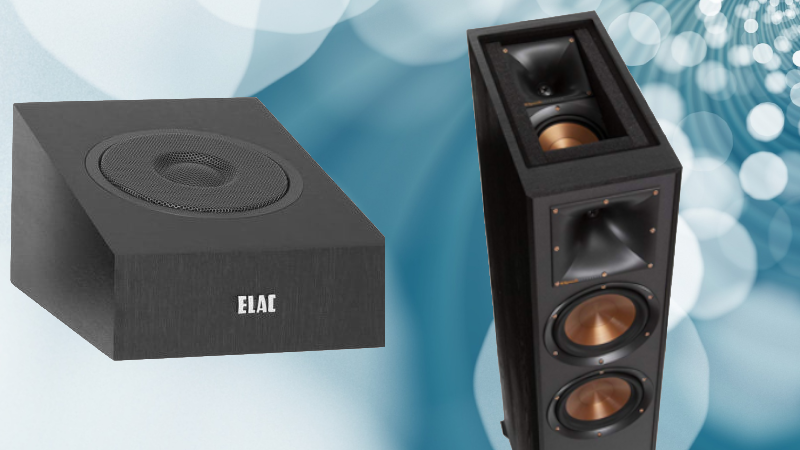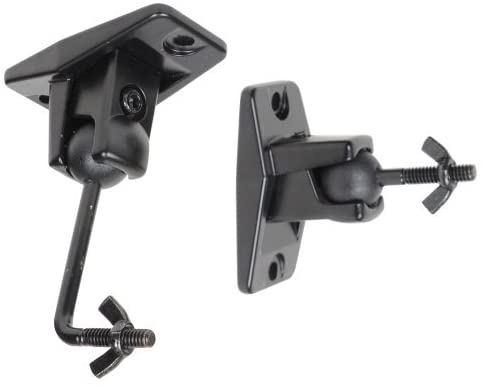High Ceiling and Atmos – What Do I Do?
When people decide to set up a sound system, they often start with the location of their TV. Where are most TVs located? In the living room. Large living spaces often enjoy high ceilings, open floorplans, and tons of light. We’ve addressed most of those issues before except for the high ceilings. While high ceilings do affect the bass (increased air volume means you’ll need a bigger subwoofer to pressurize the space), the big question is about Atmos. If you want to experience Atmos, how do you do it with very high ceilings? Let’s discuss!
Is Upfiring the Answer?
Upfiring Atmos modules are often the preferred solution for people wanting to experiment with Atmos. These speakers sit on top of your existing speakers (in the marketing images at least) and bounce sound off your ceiling (according to the images, in real life, that’s not how it works). The appeal is that you can simply place the modules in your room on your speakers and not have to install speakers in or on your ceiling.

The problem is the height. Atmos modules don’t simply bounce sound off your ceiling but they do rely somewhat on that reflected sound. The higher ceiling means the reflected sound will be much quieter than expected negating the simulated overhead effect. You could try and counteract this by placing the modules farther away from your seating, but that’s often impossible and usually impractical. If you are trying to get Atmos to work in your room with high ceilings, you are going to need to add speakers above you.
Do You Have to Add Speakers To Your Ceiling?
Many open living spaces have ceilings that are very difficult if not impossible to access from an attic. This makes running wires and installing in-ceiling speakers for Atmos nearly impossible for the DIY crowd. If you want to experiment with Atmos, you certainly aren’t looking to pay someone possibly hundreds if not thousands of dollars to install overhead speakers that you may not really end up liking.

Depending on the layout of your space, you may have another option. Angled on-wall speakers can be used to provide the overhead experience that you desire. Your TV is probably on a wall and often your seating has a wall behind it in close proximity. You can place angled speakers (Atmos modules will often work) higher up on the wall to create the Atmos effect. Solutions like the SVS Prime Elevations speakers were designed for just this situation. There are other options out there as well. Hiding the wires is much easier with on-wall speakers than overhead which is also a bonus.
What About Other Options?
There are other options for you if you can’t install in-ceiling speakers for Atmos. Of course, if you are sure you want overhead speakers, installing in-ceiling speakers is always an option (albeit an expensive one). If your ceiling doesn’t allow in-ceiling, consider on-ceiling. The Prime Elevation speakers we mentioned earlier also work on-ceiling. These are particularly good for vaulted ceilings as the angle of the speaker often offsets the slope of the ceiling. In fact, many surround speakers can be used on your ceiling with the right mount.

Consider the Distance
Lastly, you’ll want to consider the distance. A high ceiling can work just fine with Atmos as long as you plan carefully. Most people consider anything over 8 feet a “high” ceiling. Remember that the volume decreases as you move farther away from the speaker. If your ceiling is 10 or 12 feet, that isn’t a problem. But if your head is more than 12 feet from your speaker (this is the distance from your ear when you are seated to the speaker), you may run into problems. As such great distances, you need to make sure your speaker can put out enough volume without distortion to be effective. This is why the Atmos modules don’t often work in these rooms.
Fortunately, Atmos speakers aren’t often asked to put out reference-level sounds so you are unlikely to need external amplification. But at extreme distances, this may be necessary. Plan accordingly.


